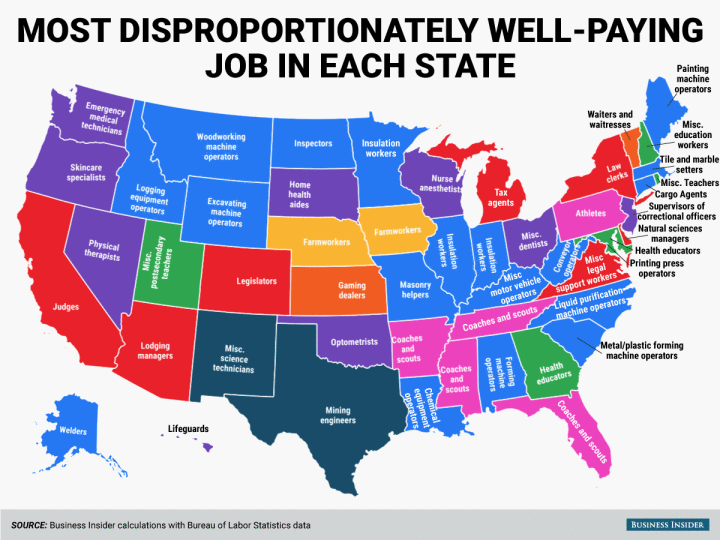Business Insider mined data from the Bureau of Labor Statistics and compared the state average salary and the national average salary for each job occupation. The single occupation with the largest percent difference is listed in the infographic below:
The income numbers are not adjusted for cost-of-living, but as that would apply to all jobs, you are still looking at the greatest outlier and thus some interesting outcomes. For example:
- The average annual salary for welders and cutters in Alaska is roughly $72,000. That’s 80% more than the national average of $40,000.
- The average annual salary for tile and marble setters in Massachusetts is roughly $75,000. That’s 70% more than the national average of $44,000.
- The average annual salary for physical therapists in Nevada is roughly $128,000. That’s 52% more than the national average of $84,000.
- The average annual salary for judicial law clerks in New York is roughly $111,000. That’s 104% more than the national average of $54,000.
I’m sure there are some economic (or “freakonomic”) explanations for some of these variations. It would also be interesting to run the same numbers for the worst paying job in each state, relative the national average.

 The Best Credit Card Bonus Offers – 2025
The Best Credit Card Bonus Offers – 2025 Big List of Free Stocks from Brokerage Apps
Big List of Free Stocks from Brokerage Apps Best Interest Rates on Cash - 2025
Best Interest Rates on Cash - 2025 Free Credit Scores x 3 + Free Credit Monitoring
Free Credit Scores x 3 + Free Credit Monitoring Best No Fee 0% APR Balance Transfer Offers
Best No Fee 0% APR Balance Transfer Offers Little-Known Cellular Data Plans That Can Save Big Money
Little-Known Cellular Data Plans That Can Save Big Money How To Haggle Your Cable or Direct TV Bill
How To Haggle Your Cable or Direct TV Bill Big List of Free Consumer Data Reports (Credit, Rent, Work)
Big List of Free Consumer Data Reports (Credit, Rent, Work)
I didn’t know Tile and marble setters made that much, that’s crazy. It sounds easy but probably not.
It is a physically demanding job, lots of time on knees and bent over, lifting and moving tile of various weights into place. Tough on the back, neck, shoulders and knees especially.
That said, this article is reporting “average” instead of median. Even the writer points out that is always a problem.
Thanks for sharing Jonathan, it would interesting to hear the “freakonomic” reasons for these variations. I think it speaks to how little awareness we all have about job market conditions. I live in Nevada and I have no idea why physical therapists make more than the average. There seems to be plenty of physical therapists around so it isn’t for lack of supply, but what is the average amount of supply. Who knows?